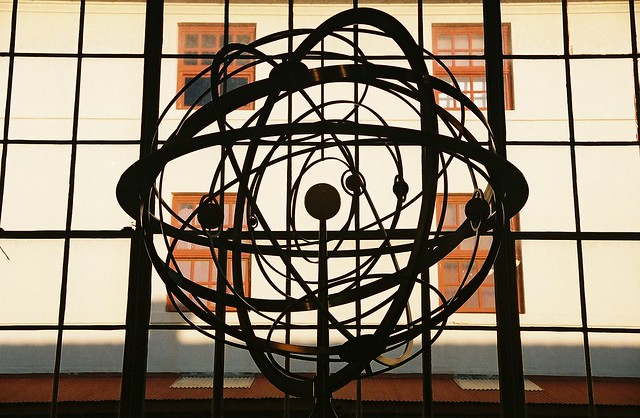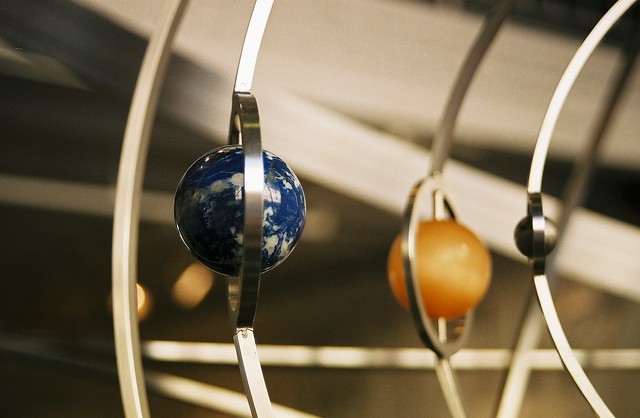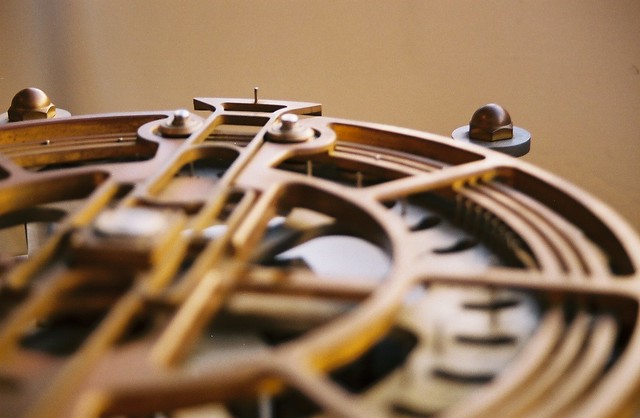
Long Now's Orrery Prototype For The 10,000 Year Clock
One of the first things that visitors see when they walk into The Interval, Long Now’s new public space, is the Orrery–a prototype for part of the 10,000 Year Clock now under construction. The Orrery is a simplified mechanical model of our solar system, a precise and durable computer, and an eight-foot-tall kinetic sculpture.
This is our 21st century interpretation of an ancient device: the first record of a planetary model dates back two millennia. While the modern design, the direct ancestor of Long Now’s Orrery, was first built in England three centuries ago.
Our Orrery’s display features the six planets that can be seen with the naked eye (Mercury through Saturn). The “bit adder” gears below the planetary display each drives a planet. The prototype is designed to update each planet’s position twice a day, so this model of the solar system can show their positions in orbit around the Sun accurately.
A kinetic sculpture of the Long Now: Mercury completes one revolution in about 88 days; the Earth takes exactly one solar year; Saturn makes it around the Sun in just under thirty years. So in the time since this prototype was first completed in 02005, Saturn would have traveled only a third of its year.
Each of the Orrery’s planets is ground from a stone that resembles the actual celestial body:
- Sun: Yellow Calcite
- Mercury: Meteorite
- Venus: Lemon Yellow Mexican Calcite
- Earth: Chilean Lapis
- Mars: Red Namibian Jasper
- Jupiter: Banded Sandstone
- Saturn: Banded Utah Onyx
Because we can look back and see that the way time has been measured throughout history has changed, it’s reasonable to imagine when looking forward that it will continue to change – our current use of hours, minutes, weeks and months may be as obscure and forgotten as the nundina, the akhet, or the gesh several millennia from now. The day, the year, and the movements of the other planets in our solar system, on the other hand, aren’t at the whim of the powers that be or of passing cultural trends. The 10,000 Year Clock, therefore, keeps track of these robust and durable units of time. The Clock’s main dial keeps track of the Sun, Moon and stars while The Orrery models our solar system.

Also robust and durable is The Orrery’s mechanical system for calculating the planets’ movements. A large and complicated gear system could do the job, but would wear down and lose accuracy over the millennia. To avoid this problem, Danny Hillis invented a device called a serial bit adder – a simple mechanical binary computer. The bit adders calculate how much to move the planets in the display based on the known input of two rotations per day by the Orrery’s central shaft. As that shaft rotates it also turns the 6 bit adder disks: one for each planet.

A bit adder consists of a rotating disk and two sets of 27mechanical pins. Each individual pin can be in one of two states and each set of pins taken altogether represents a 27 bit number. One set of pins is immovable – these are set based on the calculation that particular bit adder must perform; they are the program. The other set of pins can move between the two possible states; they represent an accumulator.
As the bit adder’s disk rotates, a portion of the disk reads the program from the unmoving bits and is moved by them. Its movements cause the other set of bits to be flipped as necessary. Each time the adder rotates, it adds the number encoded in the static pins into the number encoded by the moveable ones. That number is a fraction between zero and one. As the outer pins accumulate the value represented by the inner pins, their value grows towards one. When they surpass a value of one, the adder produces an output that adjusts its corresponding planet by way of engaging a 6-sided Geneva wheel. In this way, a precise ratio can be calculated based on the two daily rotations of the central shaft and applied to the planets in the display.
The crucial mathematical logic for the bit adders is represented in the positions of the pins, which can only ever be in one of two states even if they become significantly worn. This is a digital representation. Most traditional clocks, on the other hand, perform their mathematics in the orientation of gears around an axis. A gear measured this way can be in an infinite number of states. This is an analog representation. As the gear’s teeth become worn, its position can shift and slip, allowing inaccuracy to build up within the system over long periods of time.
The Orrery was conceptualized by Danny Hillis, with project management and additional design by Alexander Rose. Lead engineer was Paolo Salvagione, and lead machinist and fabricator was Christopher Rand. Other machinists include Erio Brown, Brian Roe, Mark Ribaud, Reason Bradley, General Precision, Oakland Machine Works, Jim Johnson, Brian Ford, Ebin Stromquist, and the base was fabricated by Seattle Solstice.

Almost a decade after its completion, the Orrery has become an iconic image for Long Now and a fixture of our public space. Many first visit The Interval because they notice the unusual 8-foot tall structure through our window, and they have to know more. For Long Now members and staff it’s an inspiring reminder of the full-scale Clock, whose Orrery will be four times the size of our prototype. In the future the Sun and six planets may be the first clue to a visitor to the Clock site as to the nature of the device they’ve just discovered.
And others are inspired to reproduce the Orrery themselves:
The Orrery is just one of many unique features of The Interval at Long Now. Come visit us and see the Orrery in person, have a delicious beverage, and enjoy all The Interval’s many pleasures. We are open 10AM to Midnight every day in San Francisco.
Join our newsletter for the latest in long-term thinking
Subscribe


